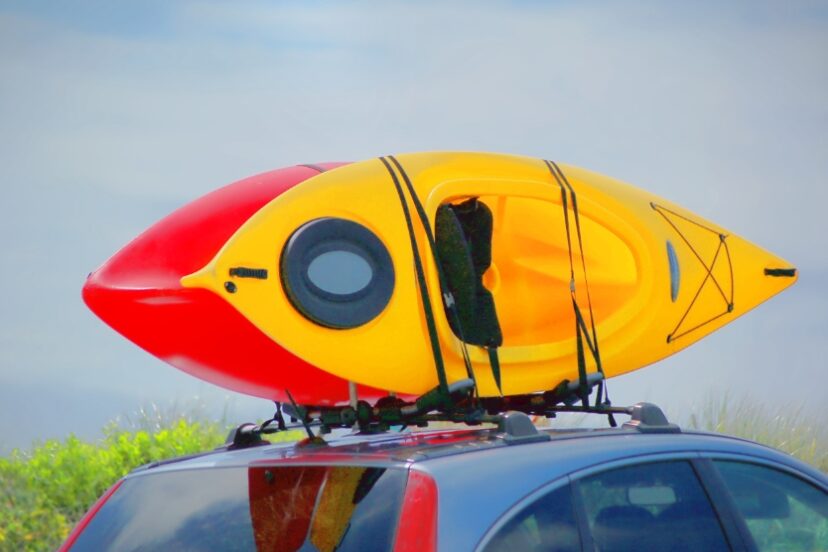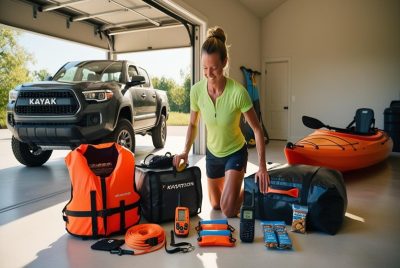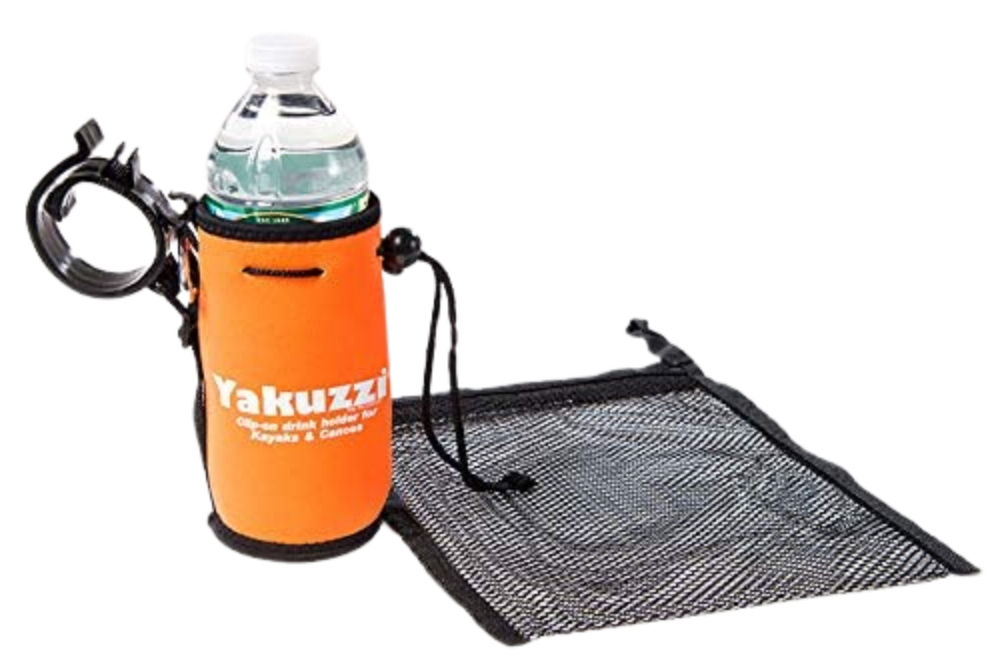The thrill of combining kayaking with fishing is an experience like no other. Gliding across serene…
10 Easy Tips For Buying A Reliable Kayak Carrier

Choosing the right kayak carrier is a pivotal decision that enhances both the safety and enjoyment of your kayaking adventures.
A dependable carrier ensures your kayak is securely transported, keeping it free from scratches and damage while you focus on the thrill of the trip ahead.
With a wide range of options available, it’s important to weigh key factors like the carrier’s compatibility with your vehicle, durability, ease of loading, and overall security.
The right carrier not only spares you unnecessary hassle but also gives you the confidence to transport your gear, no matter the distance or terrain.
To make your selection process smooth and stress-free, we’ve outlined 10 essential tips to help you identify the perfect kayak carrier for your needs and lifestyle.
1)) Consider Carrier Size
When selecting a kayak carrier, one of the most important factors to evaluate is the size of the carrier and how it aligns with the dimensions of your kayak.
Ensuring a proper fit is critical for safely securing your kayak during transportation, as a carrier that is too small or too large could lead to instability or damage.
Assess the length, width, and weight of your kayak and compare these specifications with the carrier’s capacity to ensure it can support your equipment effectively.
It’s also crucial to consider the size of your vehicle and how the carrier will fit on your roof or hitch, ensuring there is enough space for a secure setup without obstructing other vehicle functions.
By taking the time to match the carrier size to both your kayak and vehicle, you’ll guarantee a safer and more convenient transport experience.
2)) Check Weight Capacity
Ensuring the kayak carrier can handle the weight of your kayak is a key factor in making the right choice.
Each carrier has a specific weight limit, and exceeding this capacity can compromise its structural integrity, leading to potential safety hazards during transport.
To prevent this, check the manufacturer’s guidelines and confirm that the carrier can comfortably support your kayak’s weight.
Keep in mind that heavier kayaks, such as tandem or fishing models, may require carriers with reinforced materials or specialized designs to handle the additional load.
It’s also wise to factor in any extra gear you might store alongside the kayak during transit, as this could add to the overall weight.
By verifying the weight capacity of the carrier, you can ensure your kayak remains secure and avoid unnecessary strain on your vehicle.
3)) Evaluate Durability
Durability is a critical factor when selecting a kayak carrier, as it directly impacts the longevity and reliability of your investment.
A durable carrier is made from high-quality materials that can withstand various weather conditions, frequent use, and the rigors of transporting a heavy kayak.
Look for materials like corrosion-resistant metals, sturdy plastics, or reinforced nylon that provide strength without adding excessive weight.
Pay attention to construction details, such as strong welding or secure fastenings, which enhance the overall resilience of the carrier.
Weather resistance is equally important, as exposure to rain, UV rays, and temperature changes can degrade inferior materials over time.
Investing in a robust carrier ensures consistent performance over the years and prevents costly repairs or replacements due to wear and tear.
4)) Assess Ease Of Installation
Installing a kayak carrier should be a straightforward process that doesn’t require excessive time, tools, or expertise.
A carrier that is easy to set up not only saves you frustration but also ensures your kayak is mounted securely every time.
Look for carriers with intuitive mounting systems, such as slide-on rails, quick-release clamps, or tool-free designs that simplify the process.
Consider whether the carrier comes with a clear and detailed instruction manual or even video tutorials to guide you through installation.
It’s also helpful to verify compatibility with your vehicle’s roof rack system or hitch, as some carriers are designed for specific mounts.
Choosing a carrier that’s easy to install means less time spent struggling with connections and more time enjoying your kayaking adventures.
5)) Prioritize Security Features
When choosing a kayak carrier, it is essential to ensure that your equipment remains secure throughout the entire transport process.
A strong and reliable carrier should include robust security features that prevent your kayak from shifting or coming loose while driving.
Look for carriers equipped with sturdy straps, locking mechanisms, or anti-theft devices that can firmly hold the kayak in place and protect it from unauthorized removal.
Carefully examine the design of the straps or tie-down points to ensure they are easy to use and allow for a snug fit without damaging the kayak’s surface.
Some carriers also offer padded contact points or non-slip surfaces to enhance stability while safeguarding against scratches or dents.
By prioritizing security features, you can confidently transport your kayak and focus on enjoying your outdoor excursions.
6)) Compare Compatibility With Vehicle
Selecting a kayak carrier that is compatible with your vehicle is vital for ensuring a secure and efficient setup.
Begin by evaluating your vehicle’s roof rack or hitch system, as different carriers are designed to work with specific mounting platforms.
Consider the spacing of the crossbars, load-bearing capacity, and available attachment points to ensure the carrier can be securely affixed without modifications.
Some vehicles may require additional adapters or accessories to accommodate certain carrier models, so it’s important to verify these requirements in advance.
The shape and size of your vehicle also play a role, as low-clearance garages, overhangs, or extended mounts can present challenges during travel.
By carefully comparing the carrier’s design with the specifics of your vehicle, you can avoid compatibility issues and ensure a hassle-free transportation experience.
7)) Look For Weather Resistance
A reliable kayak carrier must be able to withstand exposure to diverse weather conditions, ensuring it remains functional and protects your equipment over time.
Focus on carriers constructed with materials that resist rust, corrosion, and UV damage, as these elements can significantly compromise the strength and durability of the carrier.
Water-resistant coatings on metal parts or sturdy plastics treated to endure both high heat and freezing temperatures are ideal choices.
Examine features like rubberized padding or non-slip grips, which can help maintain performance and safety during rain or other adverse conditions.
It’s worth considering how the carrier performs in windy environments as well, ensuring it keeps the kayak stable on long journeys.
Selecting a weather-resistant carrier protects both your investment and your kayak from the challenges posed by nature.
8)) Review User Reviews
Reading user reviews is an invaluable step in selecting the right kayak carrier, as it provides firsthand insights into the real-world performance of the product.
Look for feedback on key aspects such as durability, ease of use, and security features, as these are often indicators of a high-quality carrier.
Pay attention to comments about the installation process and compatibility with different vehicles to identify potential concerns or advantages.
Reviews may also highlight issues that are not immediately apparent, such as how the carrier holds up after extended use or in challenging weather conditions.
It’s helpful to focus on a combination of detailed reviews and overall ratings to form a balanced perspective.
By thoroughly examining user experiences, you can make an informed decision and select a kayak carrier that meets your needs and expectations.
9)) Verify Warranty Options
When selecting a kayak carrier, it is important to evaluate the warranty options provided by the manufacturer to protect your purchase in the long term.
A good warranty reflects the company’s confidence in its product and assures potential defects or issues.
Pay close attention to the warranty length as well as the specific terms and conditions, such as whether it covers normal wear and tear or only manufacturing faults.
Some manufacturers may even provide extended coverage or repair services, which can add value to your investment.
It is also worth checking if the warranty includes customer support or assistance for troubleshooting in case complications arise.
By verifying warranty options, you can have peace of mind knowing that your kayak carrier is backed by dependable support throughout its lifespan.
10)) Balance Cost And Quality
Finding the right balance between cost and quality is essential when choosing a kayak carrier that meets both budgetary constraints and performance expectations.
While budget-friendly options may seem appealing, it is crucial to assess whether the materials and construction can withstand frequent use and varying conditions.
Higher-priced models often feature durable materials, enhanced safety features, and user-friendly designs that justify their cost in the long run.
Carefully compare the features of different carriers within your price range, focusing on aspects like weight capacity, ease of installation, and protective measures for your kayak.
It’s also wise to consider the long-term savings provided by a well-constructed carrier, as it can reduce the need for repairs or replacements.
By thoughtfully balancing price with quality, you can ensure your kayak carrier delivers lasting value and reliable performance.
Conclusion
Choosing the right kayak carrier requires careful consideration of various factors to ensure both your kayak and vehicle are well-protected during every trip.
From evaluating compatibility and weather resistance to researching user reviews and assessing cost versus quality, each step plays a vital role in making an informed decision.
Prioritizing features like durability, ease of use, and secure mounting can greatly enhance your experience, making it simpler and safer to transport your kayak to your desired destination.
By taking the time to thoroughly review your options and invest in a carrier that meets your specific needs, you can look forward to many stress-free adventures on the water.
A dependable kayak carrier not only safeguards your equipment but also allows you to focus on enjoying the journey ahead, whether exploring serene lakes or navigating challenging rivers.





